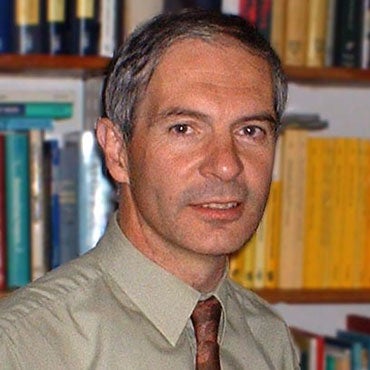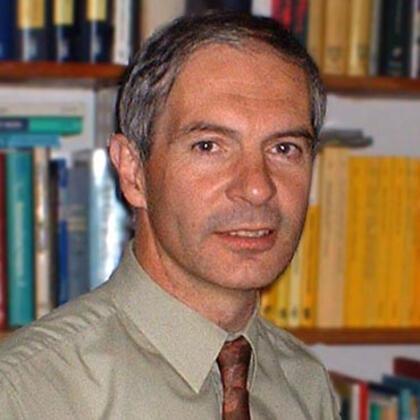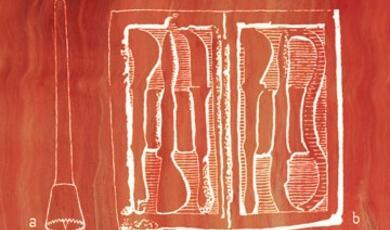Fractal Curves: From the Esoteric to the Ubiquitous
Share
- Details
- Transcript
- Audio
- Downloads
- Extra Reading
This year’s tercentenary of the death of Gottfried Wilhelm Leibniz puts Leibniz in the limelight - which is deserving both because of his involvement in challenging aspects of mathematics as well as his friendly diplomacy towards other mathematicians. The main speaker, Professor Jan van Maanen will discuss Leibniz (1646-1716) and the Curve of Quickest Descent, preceded by shorter presentations by Dr Snezana Lawrence on Hold on to Your Chairs! – the Mathematics of Whirls, Spirals, and Curves and by Professor Kenneth Falconer on Fractal Curves: from the Esoteric to the Ubiquitous.
Download Transcript
27 October 2016
Fractal Curves:
From the Esoteric to the Ubiquitous
Professor Kenneth Falconer
With the development of calculus by Newton and Leibnitz, much of mathematics and its applications in the 18th and 19th centuries related to curves or formulae to which calculus could be applied. For example, differential equations, Fourier series and the geometry of smooth surfaces and many other developments in mathematics depended on calculus. Applications included areas as diverse as planetary motion, waves and electromagnetic theory.
It was generally assumed without question that to be of any interest curves should be smooth, with a unique tangent line just touching the curve at each of its points, or at least with the exception of a small number of points. Equivalently, as you zoom in on any part of a curve it should look more and more like a straight line.
Although mathematicians almost universally studied such smooth curves, there were isolated exceptions that were introduced around 1870-1915 to demonstrate that curves could have unexpected features which did not fit in with general contemporary thinking. We will look at four examples.
The Weierstrass curve (1872)
Karl Weierstrass (1815-1897) was a German mathematician, often called ‘the father of modern analysis’, who put much of the calculus onto a rigorous basis. In an 1872 paper he wrote:
“Until very recently it was universally assumed that a continuous curve always had a tangent except at isolated points. To my knowledge, even in the writings of Gauss, Cauchy and Dirichlet there is no remark from which one can infer that these mathematicians held any other opinion. [...] One can, however, easily construct continuous functions for which it is possible to show by the simplest of means that their curves do not have a tangent at any point.”
[Uber continuirliche Functionen eines reellen Arguments, die für keinen Werth des Letzteren einen bestimmten Differentialquotienten besitzen, 1872]
Weierstrass curves are constructed by repeatedly adding sine functions of decreasing amplitude and increasing frequency, for example,
0.7sin(2.1x) + 0.72sin(2.12x) + 0.73sin (2.13x) + 0.74sin(2.14x) + 0.75sin (2.15x) + …
https://s3-eu-west-1.amazonaws.com/content.gresham.ac.uk/data/library/26oct16BSHM_KF_IMG001.jpg
Weierstrass proved rigorously that the curve given by this formula is continuous but at no point does it have a tangent. We can see this by zooming in on part of the curve.
The von Koch curve (1904)
Helge von Koch (1870-1924) was a Swedish mathematician of noble birth who worked on differential equations and number theory. But he is most remembered for his curve construction.
“Even though the example of Weierstrass has corrected the misconception [that a curve must have a tangent at most points], it seems to me that his example is not satisfactory from a geometrical point of view since the function is defined by a formula that hides the geometrical nature of the curve and one does not see why the curve has no tangent. The curve I have found is defined by a construction sufficiently simple, I believe anyone should be able to see through “naive intuition” the impossibility of the existence of a tangent.”
[Sur une courbe continue sans tangente obtenue par une constricioin géométrique élémentaire (1904)]
https://s3-eu-west-1.amazonaws.com/content.gresham.ac.uk/data/library/26oct16BSHM_KF_IMG002.jpg
The Von Koch curve has no tangent at any point and zooming in shows detail at arbitrarily fine scales.
Cantor’s ‘Devil’s Staircase’(1883)
Georg Cantor (1845-1918) now known as ‘The Father of Set Theory’, worked on rigorous properties of numbers and set theory, and in particular the nature of infinity. His results did not find favour with many contemporaries when he showed that many widely held intuitive ideas were incorrect. For example he showed ‘infinity comes in many different sizes’. “I realise that in this undertaking I place myself in a certain opposition to views widely held concerning the mathematical infinite and to opinions frequently defended on the nature of numbers.”
In an 1883 paper Cantor showed how to define a curve which seemed to contradict fundamental properties of the calculus. The curve is constructed by repeatedly splitting intervals into three and ‘lifting’ the middle portion.
https://s3-eu-west-1.amazonaws.com/content.gresham.ac.uk/data/library/26oct16BSHM_KF_IMG003.jpg
The ‘Devil’s Staircase’ curve is continuous, and is flat everywhere except above the ‘Cantor set’ which has length 0 so is negligible. Thus the value of the curve rises from 0 to 1 though virtually never going upwards. The Staircase raised questions about the ‘fundamental theorem of the calculus’ of Newton, Leibnitz and others, that differentiation and integration are inverse operations.
The Sierpiński Curve (1915)
Wacław Sierpiński (1882 -1969) was a prolific Polish mathematician noted for work on number theory, set theory and topology, in particular the topology of curves. He wanted to demonstrate that it is possible to define a curve to form an object such that every point is a ‘branching’ point, that is can be approached along three non-intersecting routes. To do this he constructed a curve now known as the Sierpiński triangle.
https://s3-eu-west-1.amazonaws.com/content.gresham.ac.uk/data/library/26oct16BSHM_KF_IMG004.jpg
Whilst it may not look like a curve at first sight, there is a well-defined route path that can be followed around the Sierpiński triangle that visits every point at least once.
Common features
These four constructions, as well as various others around late 19th and early 20th century, were specific ‘pathological’ objects designed purely to exhibit curves with particular mathematical properties, rather than because of any intrinsic elegance of their own.
Nevertheless, they have various common features:
• A simple ‘recursive’ construction, i.e. repeating a process ‘ad infinitum’
• ‘Fine structure’ - detail at arbitrarily fine scales
• Classical methods of geometry and calculus are inapplicable
• Self-similarity - e.g. von Koch curve is made up of 4 copies at scale 1/3
• Maybe a natural appearance
• ‘Dimension’ not a whole number - e.g. von Koch curve has dimension 1.26
Objects with these sorts of properties are now known as Fractals.
1900-1960
Other isolated examples of fractals were constructed from time to time to demonstrate mathematical properties. Various random fractal curves were introduced by Paul Lévy and other probabilists in the 1940s, but only to demonstrate that curves with certain statistical properties existed.
With computers still far too slow to draw intricate objects, there were few good drawings of fractals.
Benoit Mandelbrot
Benoit Mandelbrot (1924-2010) was born in Poland. In 1936 his family emigrated to France where he learnt maths with his uncle in Paris. From 1945-49 he attended the École Polytechnique in Paris, before going to the California Institute of Technology to get a Masters degree in aeronautics. From 1949-58 he worked at the Centre National de la Recherche Scientifique ‘CNRS’, getting a PhD in Mathematical Sciences and travelling widely. In 1958 he joined IBM at Yorktown Heights, New York, and was Visiting Professor at Harvard. In 1987 he became a professor in Mathematical Sciences Department at Yale.
His interests were wide-ranging, including many areas of mathematics, Fluid dynamics, Random processes, Aeronautics, Financial markets, Geology, Hydrology .... He observed that in these areas ‘irregular’ rather than ‘smooth’ behaviour was often the norm.
In the mid-1960s and 1970s computers became powerful enough to produce reasonable pictures of fractals and to allow experiment with variations. Mandelbrot had a fellowship at IBM - and made the most of the facilities available. He produced the first good pictures of a whole range of fractals.
Some of these appeared in his groundbreaking books.
1975 Les Objets Fractals: Forme Hasard et Dimension;
1977 (Translation) Fractals: Form, Chance and Dimension
1982 The Fractal Geometry of Nature
He promoted two basic principles:
• In nature, physics, biology, social science, etc., fractality is the norm rather than the exception.
“Clouds are not spheres, mountains are not cones, coastlines are not circles, and bark is not smooth, nor does lightning travel in a straight line.”
• In mathematics, irregular geometric curves and objects such as the von Koch curve or Sierpiński triangle are not isolated quirky examples, but special instances of a vast family of mathematical fractals.
Thus fractals should be studied as mathematical objects in their own right and their mathematics should be applied to physical situations.
For one instance of this, in 1919, Gaston Julia and Pierre Fatou had shown that a family of curves was very naturally associated with the formula z2 +c. But they had no idea what the curves looked like. Mandelbrot had studied their work as a student and in the late 1970s tried drawing the curves by computer. Their highly complex fractal nature became apparent.
Mandelbrot promoted a way of specifying fractal curves by defining a ‘generator’ which is repeatedly substituted in itself to give the curve. (The botanist Aristid Lindemmayer proposed a similar system in 1968 for providing a mathematical description of plants.)
The ‘generator’ idea for constructing fractals and curves has now largely been superseded. In 1981 John Hutchinson introduced what are now termed ‘iterated function systems’ to define fractals. The idea is that you can specify fractal curves and other fractals by simply specifying their self-similarities. This can be done using a ‘template’.
Remarkably, a simple template consisting of rectangles or parallelograms completely defines a fractal, as the only object which is made up of scaled copies of itself that fit into the smaller rectangles.
In conclusion
Some of the best known ‘fractal’ curves were introduced around the start of the 20th century, but purely as ‘one-off’ constructions to illustrate mathematical properties. There was no intrinsic interest in fractal objects for many years.
Since the 1980s fractal curves have been studied as a vast class in their own right, with fractal geometry now a major area of mathematics used to investigate fractal phenomena across science.
© Professor Kenneth Falconer, 2016
Further reading
Kenneth Falconer - ‘Fractals: A Very Short Introduction’, Oxford U.P.
This event was on Thu, 27 Oct 2016
Support Gresham
Gresham College has offered an outstanding education to the public free of charge for over 400 years. Today, Gresham plays an important role in fostering a love of learning and a greater understanding of ourselves and the world around us. Your donation will help to widen our reach and to broaden our audience, allowing more people to benefit from a high-quality education from some of the brightest minds.


 Login
Login







